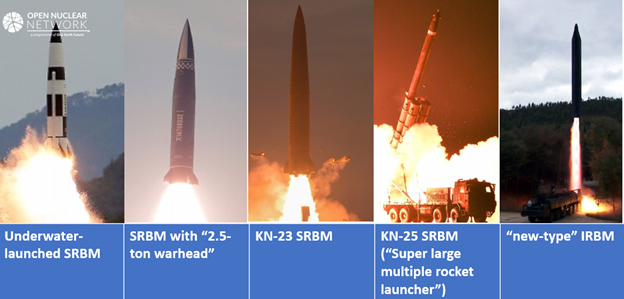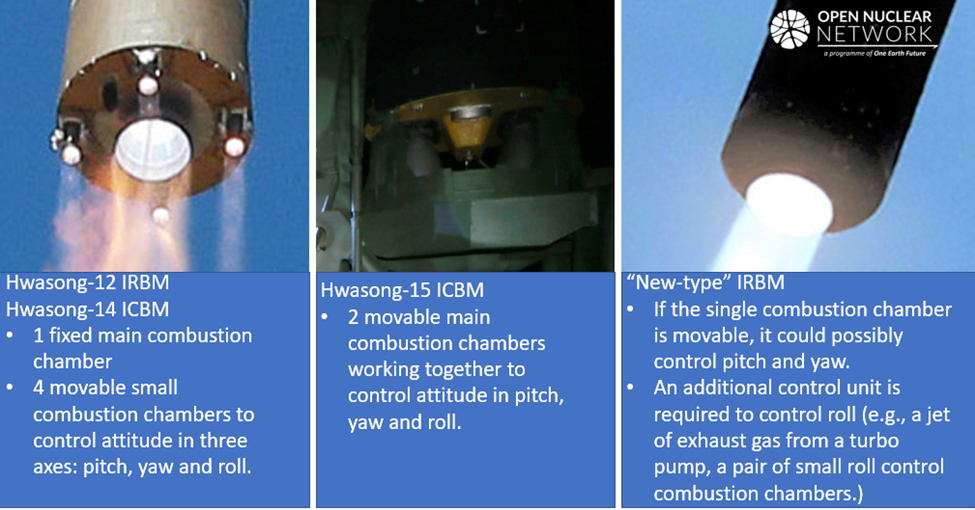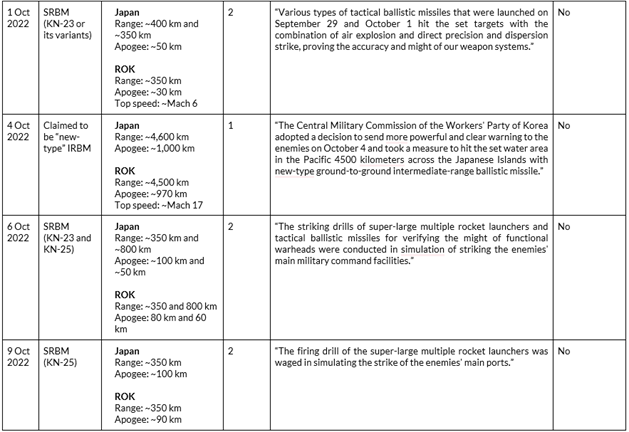The views expressed in this post are those of the author and not necessarily those of Open Nuclear Network or any other agency, institution or partner.
Executive Summary
The Democratic People's Republic of Korea (DPRK) launched a total of 12 ballistic missiles, including short-range ballistic missiles (SRBMs) and one intermediate-range ballistic missile (IRBM), on seven separate occasions from 25 September to 9 October 2022. Based on publicly available information, ONN has assessed:
-
The DPRK is likely utilizing these launches in part to signal they are willing to quickly escalate a conflict and take the initiative in a war through widespread use of nuclear weapons.
-
The apparently successful launches of SRBMs demonstrate that the DPRK has the ability to follow through on its declared posture of rapid nuclear escalation.
-
The DPRK is continuing to explore different basing modes in order to counter pre-emptive strikes against its nuclear missile force. The underwater launch canisters first revealed during this launch campaign might also be used to accommodate larger missiles of longer range in the future.
-
Available information is too limited to assess if the "new-type" IRBM launched on 4 October 2022 is indeed of a new design. The possibility that the DPRK disguised the launch of an existing IRBM (Hwasong-12) as that of a "new-type" IRBM could not be ruled out at this time.
Launch Campaign Overview
According to data from the Republic of Korea (ROK) and Japan, the ballistic missiles that were launched from 25 September to 9 October 2022 are:

Figure 1. Ballistic missiles involved in the launch campaign from 25 September to 9 October 2022. Images: KCNA [1]
Among the short-range ballistic missiles (SRBMs) launched, the KN-23 and its variants (the underwater-launched SRBM [2] and the SRBM with a "2.5-ton warhead" [3]) are often referred to as aero-ballistic missiles because they fly in a depressed trajectory and utilize aerodynamic lift in the upper atmosphere to perform manoeuvers during their flight. [4] Their so-called "pull-up" manoeuvers are meant to disrupt interception efforts. The combined use of traditional ballistic missiles and aero-ballistic missiles (as is seen in the 6 October 2022 launch, see Table 1 in the Appendix) may challenge missile defenses.
The Korean Central News Agency (KCNA) stated explicitly that the launches on 25 and 28 September 2022 were part of simulations of attacks with tactical nuclear warheads. Further comments indicate that additional tests were conducted in order to verify the power of conventional warheads. For example, KCNA stated that "various types of tactical ballistic missiles that were launched on September 29 and October 1 hit the set targets with the combination of air explosion and direct precision and dispersion strike." This suggests that conventional air burst warheads, warheads with impact fuse, and warheads with conventional sub-munitions were used.
However, as KCNA also stated that all launch drills were carried out by tactical nuclear force units, all missiles involved in the launch campaign should be viewed as potentially nuclear-capable. Another two, potentially nuclear-capable, aero-ballistic missiles developed by the Democratic People's Republic of Korea (DPRK) - the KN-24 [5] and a smaller SRBM first tested in April 2022 [6] - were apparently absent from this launch campaign.
While the DPRK stated that the missile launch campaign was a response to the joint military exercise conducted by the United States and its regional allies, [7] the DPRK may also have used this campaign to consolidate its nuclear posture after its adoption of the Law on DPRK's Policy on Nuclear Forces, which was promulgated on 8 September 2022. [8]
The launch campaign, combined with the Law on DPRK's Policy on Nuclear Forces [9] and Kim Jong Un's remarks that tactical nuclear operation units will be "deterring war and holding the initiative in the war," shows that the DPRK is signalling to the outside world that it would be willing to quickly escalate a conflict and take the initiative in a war through widespread use of nuclear weapons. The apparently successful launches of these ballistic missiles in this campaign and in previous launch events demonstrate that the DPRK also has the ability to follow through on its declared posture of rapid nuclear escalation.
The DPRK stopped covering its missile launches in State media beginning in early May 2022, around the same time the country acknowledged its COVID-19 outbreak. The DPRK subsequently announced victory over COVID-19 in early August 2022. The September/October 2022 launch campaign is the first missile activity to once again be reported by State media since April 2022. The period of unreported launches from May to August 2022 appears to correspond to the period of the DPRK's COVID-19 pandemic.
Exotic Underwater Platform
According to KCNA, a ballistic missile was launched from a canister at an underwater launching ground in a reservoir on 25 September 2022 (Figure 2). [10] This supports ONN’s previous observation that the DPRK had interest in exotic basing modes for its submarine-launched ballistic missiles (SLBMs), [11] due to constraints in the DPRK's shipbuilding industry and the overwhelming anti-submarine warfare capabilities of the United States and its regional allies. [12]

Figure 2. A ballistic missile is launched from an underwater canister in Taechon Reservoir in the northwest of the DPRK. [13] Image: KCNA [14]
The deployment of underwater launch canisters in lakes, reservoirs, and littoral waters could have far-reaching implications for the larger SLBMs that the DPRK may be developing because, if validated and deployed in the future, these launch canisters could accommodate larger missiles of longer range. [15] Also, in comparison to ballistic missile submarines, underwater canisters are significantly cheaper and easier to build.
Such an exotic basing mode could also potentially pose more challenges for the United States and its regional allies, including difficulties in locating DPRK ballistic missile launchers. Furthermore, as the failure of a reservoir could threaten nearby settlements and civilian populations, additional considerations must be given when evaluating any preemptive strike against an underwater launching platform that could critically damage the integrity of the reservoir.
A "New-Type" IRBM
The DPRK launched an intermediate-range ballistic missile (IRBM) on 4 October 2022. It reportedly flew ~4,500 km with an apogee of ~1,000 km. This is the fifth confirmed IRBM launch, the second this year, and the third to overfly the main islands of Japan (Figure 3). [16]

Figure 3. Five confirmed launches of DPRK IRBMs. Images: KCNA [17]
The DPRK claimed that, instead of the Hwasong-12 IRBM, a "new-type ground-to-ground intermediate-range ballistic missile" was used for this launch. The photos released by KCNA showed some visual differences between this "new-type" IRBM and the Hwasong-12 (Figure 3).
The following considerations, however, would suggest that image manipulation might have been involved in order to create a false impression of this missile:
-
DPRK referred to this IRBM only as a "new-type" IRBM, without explicitly mentioning its designation. Conversely, DPRK media has in the past provided designations for every IRBM and ICBM that the country has launched.
-
Flying a new and untested IRBM over the main islands of Japan involves some risk. Before the Hwasong-12 IRBM was launched to overfly Japan in August and September 2017, the Hwasong-12 and Hwasong-14 (a small ICBM built on the basis of the Hwasong-12) had been successfully flight tested in highly lofted trajectories three times.
-
Based on available images, it is difficult to determine what mechanism was applied for the roll control of the missile (Figure 4). The bottom of this "new-type" IRBM also looks too rounded and smooth for a liquid propellant ballistic missile of this type (Figure 4), indicating that image manipulation may have been involved.
-
It is unclear what benefit or advantage the DPRK would gain by producing an iteration of IRBM that is possibly based on the proven Hwasong-12 design.
-
The DPRK has been known to release disinformation in the past regarding missile tests, with the latest example being the possible disguise of the March 2022 launch of an existing ICBM (Hwasong-15), falsely claiming that it was the launch of a new, larger one (Hwasong-17). [18]

Figure 4. Comparison of the propulsion units between existing Hwasong strategic missiles and the “new-type” IRBM. Images: sogwang media corporation, KCNA, KCNA/Reuters [19]
In conclusion, currently available information is too limited to determine if the missile is indeed of a new type. The possibility that the DPRK disguised the launch of an existing IRBM (Hwasong-12) could not be ruled out at this time.
Finally, it is worth noting that KCNA stated this new IRBM was launched by a tactical nuclear force unit. According to the only publicly known classification of nuclear weapons in the DPRK, a nuclear weapon carried by an IRBM should be categorized as a strategic nuclear weapon. [20] However, it remains unclear what criteria are actually being used by the DPRK to define tactical nuclear weapons, or if said classification has been updated since its publication in 2013.
Appendix


Table 1. Compilation of information regarding each launch in the campaign from 25 September to 9 October 2022. Sources: Yonhap News Agency, [21] Ministry of Defense, Japan, [22] KCNA [23]
[1] Respected Comrade Kim Jong Un Guides Military Drills of KPA Units for Operation of Tactical Nukes, KCNA, 10 October 2022, available at: http://kcna.kp/en/article/q/b99a0b7ec8b44d08af33e5402ebf5d6c.kcmsf
[2] The missile was first tested in October 2021 as a submarine-launched ballistic missile (SLBM) and was launched from an experimental ballistic missile submarine. See: Tianran Xu, Brief on the 19 October 2021 Submarine-Launched Ballistic Missile Test of the Democratic People's Republic of Korea, Open Nuclear Network, 21 October 2021, available at: https://opennuclear.org/publication/brief-19-october-2021-submarine-launched-ballistic-missile-test-democratic-peoples
[3] The 2.5-ton warhead probably refers to the total mass of the missile after burnout. As the solid booster is not jettisoned after burnout, the whole missile could be regarded as the warhead. For more information regarding this missile, see: Veronika Bedenko, Clayton Besaw, Jaewoo Shin & Tianran Xu, ONN Korean Peninsula Risk Assessment, March 2021, Open Nuclear Network, 3 April 2021, available at: https://opennuclear.org/publication/onn-korean-peninsula-risk-assessment-march-2021
[4] Veronika Bedenko, Clayton Besaw, Jaewoo Shin & Tianran Xu, ONN Korean Peninsula Risk Assessment, March 2021, Open Nuclear Network, 3 April 2021, available at: https://opennuclear.org/publication/onn-korean-peninsula-risk-assessment-march-2021
[5] Tianran Xu, January 2022: Missile Tests of the DPRK, Open Nuclear Network, 1 February 2022, available at: https://opennuclear.org/publication/january-2022-missile-tests-dprk
[6] Tianran Xu, Increasing Nuclear Risk on the Korean Peninsula: the DPRK's Pursuit of Tactical Nuclear War-Fighting Capabilities, Open Nuclear Network, 25 April 2022, available at: https://opennuclear.org/publication/increasing-nuclear-risk-korean-peninsula-dprks-pursuit-tactical-nuclear-war-fighting
[7] Respected Comrade Kim Jong Un Guides Military Drills of KPA Units for Operation of Tactical Nukes, KCNA, 10 October 2022, available at: http://kcna.kp/en/article/q/b99a0b7ec8b44d08af33e5402ebf5d6c.kcmsf
[8] Law on DPRK's Policy on Nuclear Forces Promulgated, KCNA, 9 September 2022, available at: http://kcna.kp/en/article/q/5f0e629e6d35b7e3154b4226597df4b8.kcmsf
[9] "In case the need for operation for preventing the expansion and protraction of a war and taking the initiative in the war in contingency is inevitably raised", see: Law on DPRK's Policy on Nuclear Forces Promulgated, KCNA, 9 September 2022, available at: http://kcna.kp/en/article/q/5f0e629e6d35b7e3154b4226597df4b8.kcmsf
[10] Respected Comrade Kim Jong Un Guides Military Drills of KPA Units for Operation of Tactical Nukes, KCNA, 10 October 2022, available at: http://kcna.kp/en/article/q/b99a0b7ec8b44d08af33e5402ebf5d6c.kcmsf
[11] The missile launched on 25 September 2022 was first tested in October 2021 as an SLBM, and was launched from an experimental ballistic missile submarine. See: Tianran Xu, Brief on the 19 October 2021 Submarine-Launched Ballistic Missile Test of the Democratic People's Republic of Korea, Open Nuclear Network, 21 October 2021, available at: https://opennuclear.org/publication/brief-19-october-2021-submarine-launched-ballistic-missile-test-democratic-peoples
[12] Tianran Xu, Constraints and Outlook: Future Deployment of DPRK Ballistic Missile Submarines, Open Nuclear Network, 5 January 2022, available at: https://opennuclear.org/publication/constraints-and-outlook-future-deployment-dprk-ballistic-missile-submarines
[13] Joseph S. Bermudez, Jennifer Jun, Missile Test from Taechon Reservoir: SRBM, not SLBM, Beyond Parallel, 12 October 2022, available at: https://beyondparallel.csis.org/missile-test-from-taechon-reservoir-srbm-not-slbm/
[14] Respected Comrade Kim Jong Un Guides Military Drills of KPA Units for Operation of Tactical Nukes, KCNA, 10 October 2022, available at: http://kcna.kp/en/article/q/b99a0b7ec8b44d08af33e5402ebf5d6c.kcmsf
[15] Tianran Xu, Emerging Capabilities? The Unflown SLBMs of the DPRK, Open Nuclear Network, 25 July 2022, available at: https://opennuclear.org/publication/emerging-capabilities-unflown-slbms-dprk
[16] DPRK space launch vehicles also overflew the main islands in the 1998 and 2009 satellite launch attempts. Though these satellite carriers share ballistic missile technologies, they are better categorized as space launch vehicles.
[17] Respected Comrade Kim Jong Un Guides Military Drills of KPA Units for Operation of Tactical Nukes, KCNA, 10 October 2022, available at: http://kcna.kp/en/article/q/b99a0b7ec8b44d08af33e5402ebf5d6c.kcmsf
[18] Allies view N. Korea's ICBM launch as involving Hwasong-15, not new missile: sources, Yonhap News, 27 March 2022, available at: https://en.yna.co.kr/view/AEN20220327002200325. Tianran Xu, 24 March 2022 DPRK ICBM Test, Open Nuclear Network, 25 March 2022, available at: https://opennuclear.org/publication/24-march-2022-dprk-icbm-test
[19] Cynthia Kim and Josh Smith, North Korea says missile tests simulate striking South with nuclear weapons, Reuters, 10 October 2022, available at: https://www.reuters.com/world/asia-pacific/nkoreas-kim-jong-un-oversaw-tactical-nuclear-military-training-2022-10-09/
[20] Tianran Xu, Backgrounder: Previous DPRK Nuclear Tests, Open Nuclear Network, 17 June 2022, available at: https://opennuclear.org/publication/backgrounder-previous-dprk-nuclear-tests
[21] Song Sang-ho, N. Korea fires one short-range ballistic missile into East Sea: S. Korean military, Yonhap News Agency, 25 September 2022, available at: https://en.yna.co.kr/view/AEN20220925000355325. (URGENT) N.K. missiles flew about 360 km at apogee of some 30 km at top speed of Mach 6: S. Korean military, Yonhap News Agency, 28 September 2022, available at: https://en.yna.co.kr/view/AEN20220928009500325. (URGENT) N.K. missiles flew some 350 km at apogees of around 50 km at top speed of Mach 5: S. Korean military, Yonhap News Agency, 29 September 2022, available at: https://en.yna.co.kr/view/AEN20220929010500325. Song Sang-ho, (5th LD) N. Korea fires 2 ballistic missiles into East Sea: S. Korean military, Yonhap News Agency, 1 October 2022, available at: https://en.yna.co.kr/view/AEN20221001000455325. Song Sang-ho, (4th LD) N. Korea fires IRBM over Japan: S. Korean military, Yonhap News Agency, 4 October 2022, available at: https://en.yna.co.kr/view/AEN20221004001354325. (2nd LD) N. Korea fires 2 short-range ballistic missiles into East Sea: S. Korean military, Yonhap News Agency, 6 October 2022, available at: https://en.yna.co.kr/view/AEN20221006000853325. Song Sang-ho, “(3rd LD) N. Korea fires 2 short-range ballistic missiles toward East Sea: S. Korean military, Yonhap News Agency, 9 October 2022, available at: https://en.yna.co.kr/view/AEN20221009000353325
[22] 2022 MoD press statements (in Japanese), Ministry of Defense, Japan, available at: https://www.mod.go.jp/j/press/news/index.html
[23] Respected Comrade Kim Jong Un Guides Military Drills of KPA Units for Operation of Tactical Nukes, KCNA, 10 October 2022, available at: http://kcna.kp/en/article/q/b99a0b7ec8b44d08af33e5402ebf5d6c.kcmsf